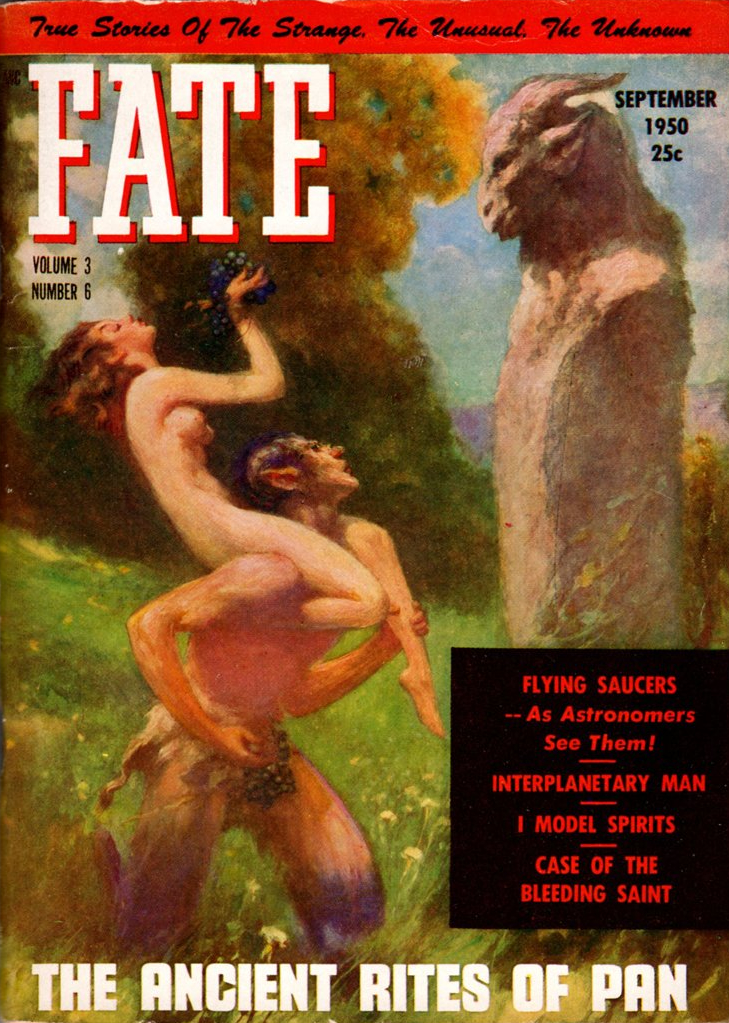In ancient Greek religion and mythology, Pan is the god of the wild, shepherds and flocks, rustic music and impromptus, and companion of the nymphs. He has the hindquarters, legs, and horns of a goat, in the same manner as a faun or satyr. With his homeland in rustic Arcadia, he is also recognized as the god of fields, groves, wooded glens, and often affiliated with sex; because of this, Pan is connected to fertility and the season of spring. In Roman religion and myth, Pan’s counterpart was Faunus, a nature god who was the father of Bona Dea, sometimes identified as Fauna; he was also closely associated with Sylvanus, due to their similar relationships with woodlands. The worship of Pan began in Arcadia which was always the principal seat of his worship. Arcadia was a district of mountain people, culturally separated from other Greeks. Arcadian hunters used to scourge the statue of the god if they had been disappointed in the chase. Being a rustic god, Pan was not worshipped in temples or other built edifices, but in natural settings, usually caves or grottoes such as the one on the north slope of the Acropolis of Athens. These are often referred to as the Cave of Pan. The only exceptions are the Temple of Pan on the Neda River gorge in the southwestern Peloponnese – the ruins of which survive to this day – and the Temple of Pan at Apollonopolis Magna in ancient Egypt. In the 4th century BC Pan was depicted on the coinage of Pantikapaion. Pan’s goatish image recalls conventional faun-like depictions of Satan. The similarities between conventional representations of Pan and the Devil were observed by the occultists Aleister Crowley and Anton Szandor LaVey.
| Alias Pan, Faunus |
| Real Names/Alt Names Pan, Faunus |
| Characteristics Trickster, Myths & Legends, Cryptid, Deity, Prehuman Epoch |
| Creators/Key Contributors Unknown |
| First Appearance Greek mythology |
| First Publisher ○ |
| Appearance List Literature: Pindar’s Pythian Ode (470 BC), Herodotus’ Histories (430 BC), Homeric Hymn to Pan (seventh century BC), Ovid’s Metamorphoses (8 CE), Plutarch’s De defectu oraculorum (On the Decline of Oracles, 83 AD), Richard Payne Knight’s Discourse on the Worship of Priapus (1786), John Keats’s “Endymion” (1818), Elizabeth Barrett Browning’s “The Dead Pan” (1844), Robert Louis Stevenson’s essay “Pan’s Pipes” (1878), Algernon Charles Swinburne’s poem “A Nympholept” (1894), Arthur Machen’s The Great God Pan (1894) [PG], Kenneth Grahame’s The Wind in the Willows (1908), The Story of Greece: Told to Boys and Girls by Mary Macgregor (191-?) [Internet Archive], G.K. Chesterton’s “The End of the World” in The Everlasting Man (1925), Lord Dunsany’s The Blessing of Pan (1927), Margaret Murray’s The God of the Witches (1933), Károly Kerényi’s The Gods of the Greeks (1951), Robert Graves’ The Greek Myths (1955), “Pagan Rites of Pan” in Fate magazine (Dec 1958). |
| Sample Read The Great God Pan (1894) [Internet Archive] |
| Description In ancient Greek religion and mythology, Pan is the god of the wild, shepherds and flocks, rustic music and impromptus, and companion of the nymphs. He has the hindquarters, legs, and horns of a goat, in the same manner as a faun or satyr. With his homeland in rustic Arcadia, he is also recognized as the god of fields, groves, wooded glens, and often affiliated with sex; because of this, Pan is connected to fertility and the season of spring. In Roman religion and myth, Pan’s counterpart was Faunus, a nature god who was the father of Bona Dea, sometimes identified as Fauna; he was also closely associated with Sylvanus, due to their similar relationships with woodlands. The worship of Pan began in Arcadia which was always the principal seat of his worship. Arcadia was a district of mountain people, culturally separated from other Greeks. Arcadian hunters used to scourge the statue of the god if they had been disappointed in the chase. Being a rustic god, Pan was not worshipped in temples or other built edifices, but in natural settings, usually caves or grottoes such as the one on the north slope of the Acropolis of Athens. These are often referred to as the Cave of Pan. The only exceptions are the Temple of Pan on the Neda River gorge in the southwestern Peloponnese – the ruins of which survive to this day – and the Temple of Pan at Apollonopolis Magna in ancient Egypt. In the 4th century BC Pan was depicted on the coinage of Pantikapaion. Pan’s goatish image recalls conventional faun-like depictions of Satan. The similarities between conventional representations of Pan and the Devil were observed by the occultists Aleister Crowley and Anton Szandor LaVey. |
| Source Pan (god) – Wikipedia |

